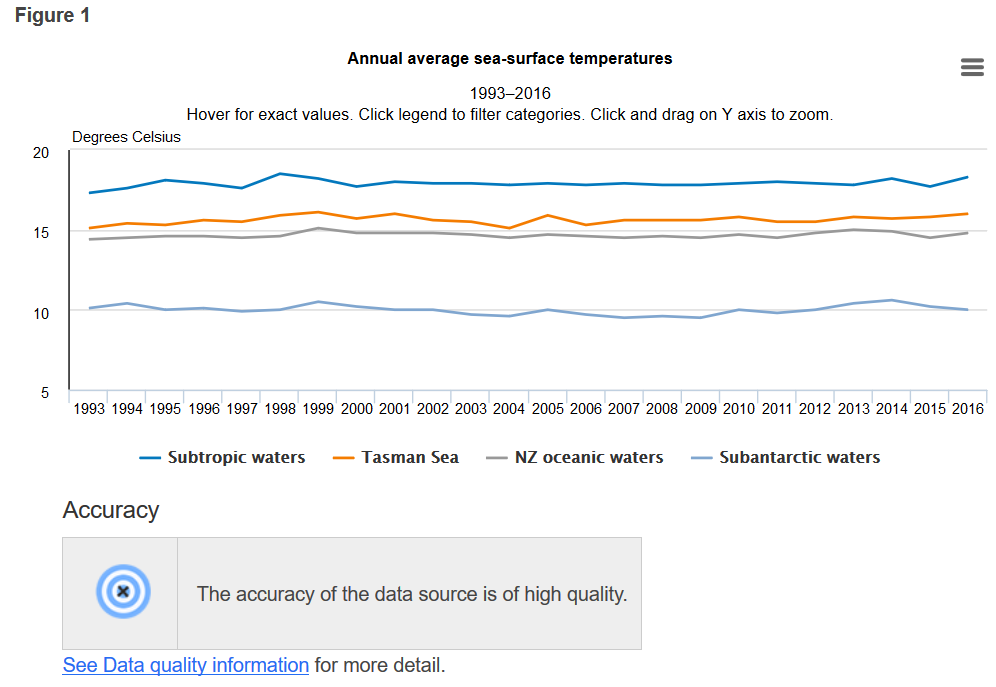Eeny, meeny, NIWA, mo. Pick a number; you’re good to go. That’s the state of climate science at the Ministry for Environment, it’s absolutely farcical, and that’s a fact.
Just two years ago NIWA announced that for the period 1993-2016 the oceans surrounding New Zealand showed no discernible increase in temperature. The monitoring of ocean temp’s from satellite observations has been relatively long-standing, the methodology comprehensively reviewed and standardised with NIWA proclaiming absolute faith in the processes and findings of their decades of research:

Fast-forward just two years and suddenly everything has changed. Beggaring belief our Ministry for Environment claims that, according to NIWA, New Zealand oceans have been heating up at some of the highest rates in the world for the last four decades! (The global average increase is 0.11° per decade)
“Key results were as follows:
• Oceanic SST: Significant positive trends 1981-2018 in SST at the EEZ scale, and in four descriptive regions (Chatham Rise, Tasman Sea, Subtropical Water, Subantarctic Water), with average trends of 0.1–0.2°C per decade which is similar to the global average rate of ocean warming.”
What the heck happened here? Has pressure been put on NIWA to abandon their earlier science and produce something more suited to the doom-spruik global-warming narrative? And if so, how do they justify the new numbers because the differences between the two statements are irreconcilable.
Confused, I asked MfE what was going on, and interestingly, the correspondent from MfE fibbed:
“the processing and spatial resolution of the satellite sensor data used in this recent 2019 analysis improves on past updates and this allows us to be more confident in determining trends. The statement “no trend could be determined” from 2016/2017 referred to a different time period (1993-2016) where less data was available.” [emphasis mine]
The writer from MfE assured me NIWA were “confident” about the figures, quoting ‘Pinkerton, et al 2019’.
I was surprised then, to find on reading ‘Pinkerton, et al 2019’, the warming claim is not based on improvement but a different analysis including (curiously) the “temperature-estimation algorithms” of the very same data used to produce the earlier results, and that the authors are not confident at all of the re-interpreted results. In a section discussing the contradictions arising from the more recent figures the authors write:
“It is not known which [sst] product should be preferred for state of the Environment reporting…”
While in the summary they go further:
“At present, it is not possible to recommend using one SST dataset over another.”
You’ve got to feel a little sorry for Principal Scientist Matt Pinkerton; he put the riders in the report but MfE just went ahead and ignored them. While Pinkerton says, “it is not possible to recommend using one SST dataset over another”, MfE choose the one that suits them.
Amazing, eh?
Poor Mr Pinkerton also pleads for something eminently sensible – he reckons they should go and physically take the ocean’s temperature:
“Comparison of satellite measurements of SST with in situ measurements (from coastal stations and research vessels) may be useful in helping to recommend the appropriate data to use for New Zealand environmental reporting in the future.”
Sorry; Matt, no chance. Why go out and measure the stuff when MfE can have you pore over the numbers and input different algorithms until they get a result they want?









